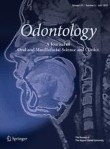
Abstract
To analyze the effects of four universal adhesives (Optibond Solo Plus—OB, Universal Bond—UB, Prime&Bond Active—PBA, FuturaBond M + —FB) on human gingival fibroblasts in terms of cytotoxicity, morphology and function. After in vitro exposure for up to 48 h, fibroblast viability was determined by the MTT assay determined, morphology by phase-contrast microscopy and migration by the scratch wound assay. Expression levels of IL1β, IL6, IL8, IL10, TNFα and VEGF genes were assessed by RT-PCR and their protein production by Western blot analysis. Apoptosis and cell cycle were analyzed by flow cytometry. OB and UB induced early morphological changes on fibroblasts (3 h) with extended cell death at 24 h/48 h. Gene expression of collagen type I and fibronectin increased fivefold compared with controls, elastin disappeared and elastase increased threefold, indicating gingival tissue tended to become fibrotic. Only UB and OB increased g ene expression of inflammatory markers: IL1β at 3 and 48 h (up to about three times), IL6 and IL8 at 3 h (up to almost four times) which corresponded to the increase of the activated form NF-kB. All adhesives showed an effect on the functionality of fibroblasts with cytotoxic effect time and concentration dependent. Among all the OB and UB adhesives, they showed the greatest cell damage. The in-depth analysis of the effects of universal adhesives and possible functional effects represents an important information for the clinician towards choosing the most suitable adhesive system.
Δεν υπάρχουν σχόλια:
Δημοσίευση σχολίου
Σημείωση: Μόνο ένα μέλος αυτού του ιστολογίου μπορεί να αναρτήσει σχόλιο.